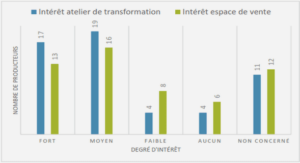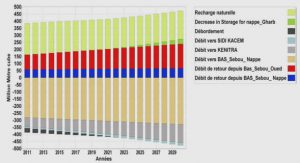Cours forest description and harvest treatments in western Quebec., tutoriel & guide de travaux pratiques en pdf.
Materials and methods
Study sites
This study used 23 sites from a larger network established by the Ministère des Forêts, de la Faune et des Parcs, Quebec, Canada (MFFP) in order to monitor operational effects of selection cutting. The network is composed of 282 stands managed under Timber Supply and Forest Management Agreements. It includes a total of 971 permanent plots distributed in paired treated and control areas. Both areas presented similar characteristics, did not had recent interventions and were located close one to each other. The harvesting activities took place between 1995 and 1999 and were conducted according to operational guidelines. For the study, only groups of permanent plots (treated and control) located in mixedwood stands with a minimum of 10% of the merchantable basal area in white-cedar before harvesting activities were selected. Difficult access to certain areas 20 years after the first data collection allowed a total of 70 permanent plots to be retained for the study. Permanent plots were 400 m2 in area (circular plot of 11.28 m radius) and were measured by MFFP before harvesting and 0, 5 and 10 years after harvesting. Data from these inventories were provided according to a collaboration agreement between MFFP and Laval University. Additional regeneration and browsing inventories were conducted for this study during summer 2014.
The sites were located in three different regions of western Quebec. Nine sites were located approximately 100 km South East of the town of Ville-Marie in the Témiscamingue Region (47°20’N, 79°26’W), four sites were located 65 km north of the town of Mont-Laurier in the Hautes-Laurentides Region (46°33’N, 75°30’W) and the remaining sites were located 70 km North of the town of Ottawa in the Outaouais Region (45°90’N, 75°62’W). Most of the sites are within the sugar maple-yellow birch bioclimatic domain but the four northernmost lie within the Balsam fir-yellow birch bioclimatic domain (figure 3). Mean annual temperature ranges from 2.5 to 5.0 °C and mean annual precipitation reaches 1000 mm for the sugar maple-yellow birch bioclimatic domain (Saucier et al. 2009). For the Balsam fir-yellow birch bioclimatic domain, the mean annual temperature range is lower (1.5 to 2.5 °C) and the precipitation is slightly higher (1100 mm). Undifferentiated till was the main surface deposit, all sites are mesic and elevation ranged from 260 to 485 meters.
Figure 3: Location of the study sites within bioclimatic subdomains.
Forest description and harvest treatments
The majority of the plots were located in mixedwood stands dominated by deciduous species. The most representative stand types were dominated by yellow birch (Betula alleghaniensis Britt.) with a minor component of white-cedar or sugar maple (Acer saccharum Marsh.). Mixedwood stands dominated by sugar maple or evergreen species such as hemlock (Tsuga canadensis (L.) Carrière) or white-cedar were also found on a few plots. Table 1 presents the main forest stands and the distribution of the plots. Table 2 shows the characteristics before, after, and 10 years after harvesting for the main types of mixedwood stands. Before the treatment, mean diameter at breast height (DBH measured at 1.3 m) was 21.1 cm, mean basal area was 24.3 m2/ha and mean basal area in white-cedar was 4.6 m2/ha. After treatment, mean DBH increased by 1.0 cm while mean basal area decreased by 1.5 m2/ha. The white-cedar basal area has not decreased much, suggesting that very few stems were targeted during the selection cutting. Ten years after treatment, mean DBH increased to 23.0 cm, mean basal area increased to 25.6 m2/ha and mean basal area in white-cedar increased slightly from 4.2 m2/ha to 4.4 m2/ha.
Horizontal stand structure was mostly heterogeneous and the vertical structure was irregular with multiple layers. The understory was composed of a mix of competing species such as striped maple (Acer pennsylvanicum L.), mountain maple (Acer spicatum Lamb.), squashberry viburnum (Viburnum edule (Michx) Raf.) and saplings of species forming the canopy. There was no major disturbance reported, only a few stems were affected by minor windfall.
Table 1 : Number of plots by stand type
Table 2: Characteristics before, after and 10 years after harvesting
The plots are located in the northern part of the distribution of white-tailed deer (Odocoileus virgianus Zimmerman) populations (Hébert et al. 2013). In the Témiscamingue region, densities of white-tailed deer are difficult to evaluate because there is no hunting record. In the Outaouais and the Hautes-Laurentides regions, the population densities of white-tailed deer in 2011 were estimated at about 0 to 2 deer/10 km2 (Hébert et al. 2013). However, moose (Alces alces Gray) are also present in the study area and the populations in 2008 were estimated as 2.8 ± 0.3 moose/10 km2 for the Témiscamingue region and slightly lower (2.4 ± 0.3 moose/10 km2) for the Outaouais and Hautes-Laurentides regions (Lefort and Massé 2015). Hare (Lepus americanus Erxleben) was not abundant in the study sites, only occasional and random browsing was observed on regeneration in a few sites.
Plots implementation
Regeneration and browsing inventory
In each 400 m2 permanent plot, a regeneration survey was carried out between June and August 2014, 15 to 19 years after harvesting activities depending on the sites. The seedlings (DBH < 1.1 cm) were numbered in 10 circular 4 m2 subplots and all the saplings, including non-commercial tree species, were counted by species in 2 cm DBH classes (DBH between 1.1 and 9.0 cm) in one circular 100 m2 plot (figure 4). The distance between each center of 4 m2 subplots was 5 meters. As the requirements of the seedlings are not the same according to their stage of development, it became interesting to distinguish the seedling height classes. We distinguished three demographic categories for the regeneration based on seedling height. We classified all the regeneration between 15 to 30 cm tall as “small seedlings”, those from 31 to 100 cm as “medium seedlings” and those higher than 101 cm but smaller than 1.1 cm DBH as “large seedlings”. Seedlings between 0 and 15 cm were not inventoried because they were not considered as established. The establishment phase extends from seed germination until juvenile mass mortality is no longer to be feared and seedlings are able to react to canopy opening (Larouche 2009). No distinction between sexual and asexual reproduction was made because of the difficulties in differentiating both types on established seedlings without destroying them. Percent cover of the understory layer was estimated in each subplot to evaluate understory competition. Percent cover includes all concurrent species taller than seedlings (> 15 cm) such as herbaceous, shrubs and abundant species of the understory like striped maple, mountain maple, squashberry viburnum and saplings of species forming the canopy. Browsing was assessed on each seedling in subplot by herbivore type (deer or moose, and hare) and by percentage of the foliage consumed. For each white-cedar seedling, characterization of the establishment microsite was carried out according to microtopography and litter type at the rooting site (table 3). Characterization according to the same categories was also made for the center of each 4 m2 subplot to estimate microsite and litter availability.






